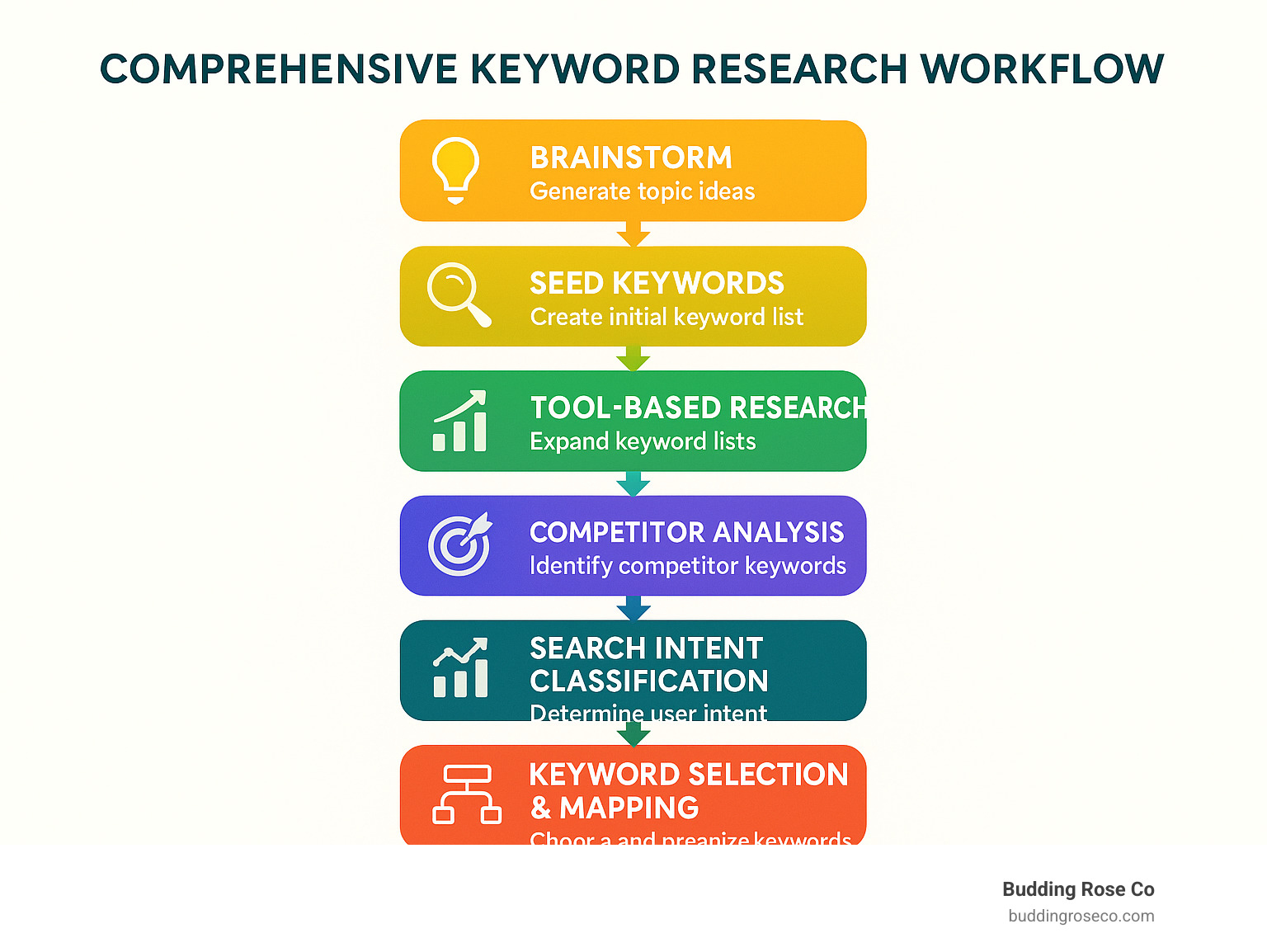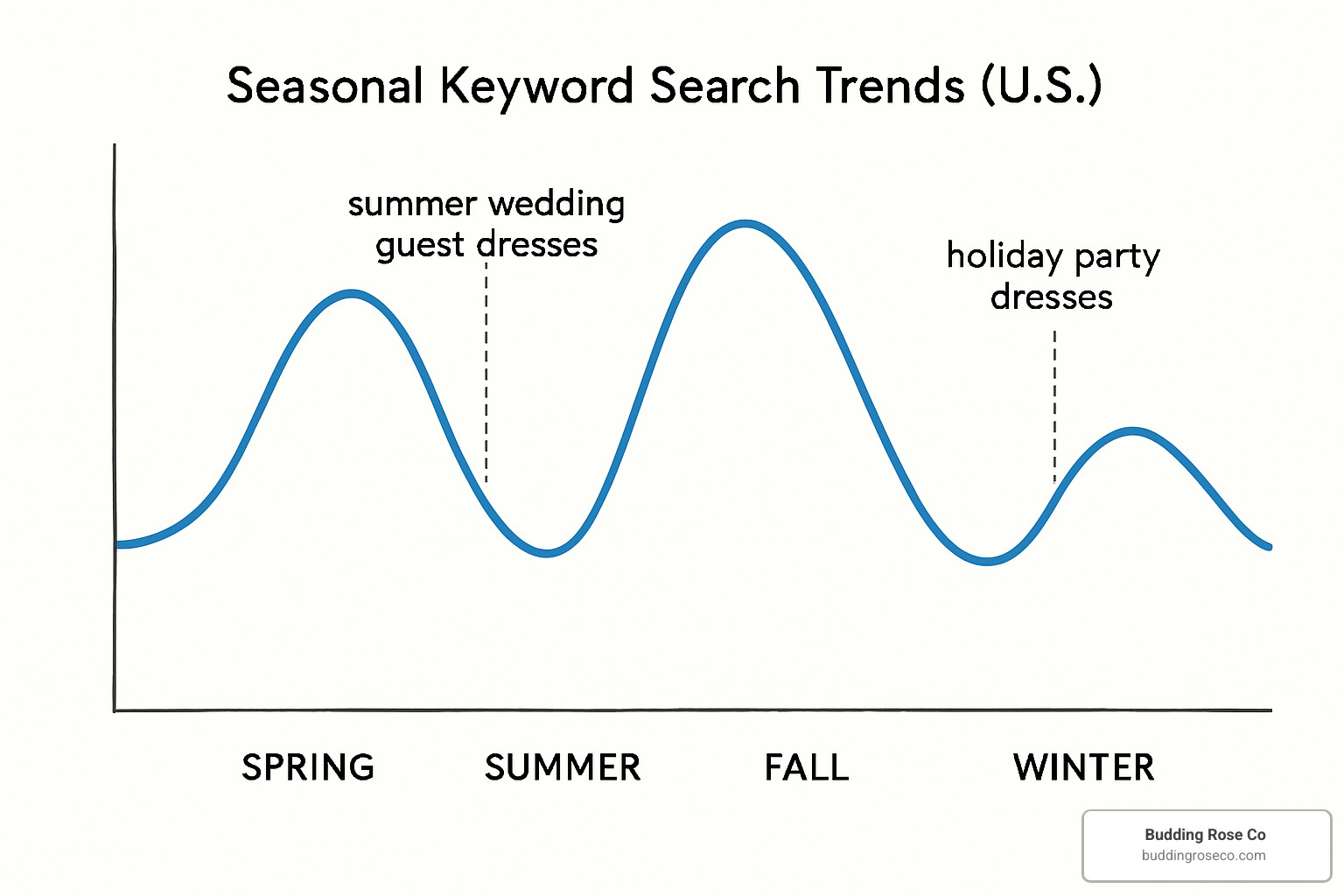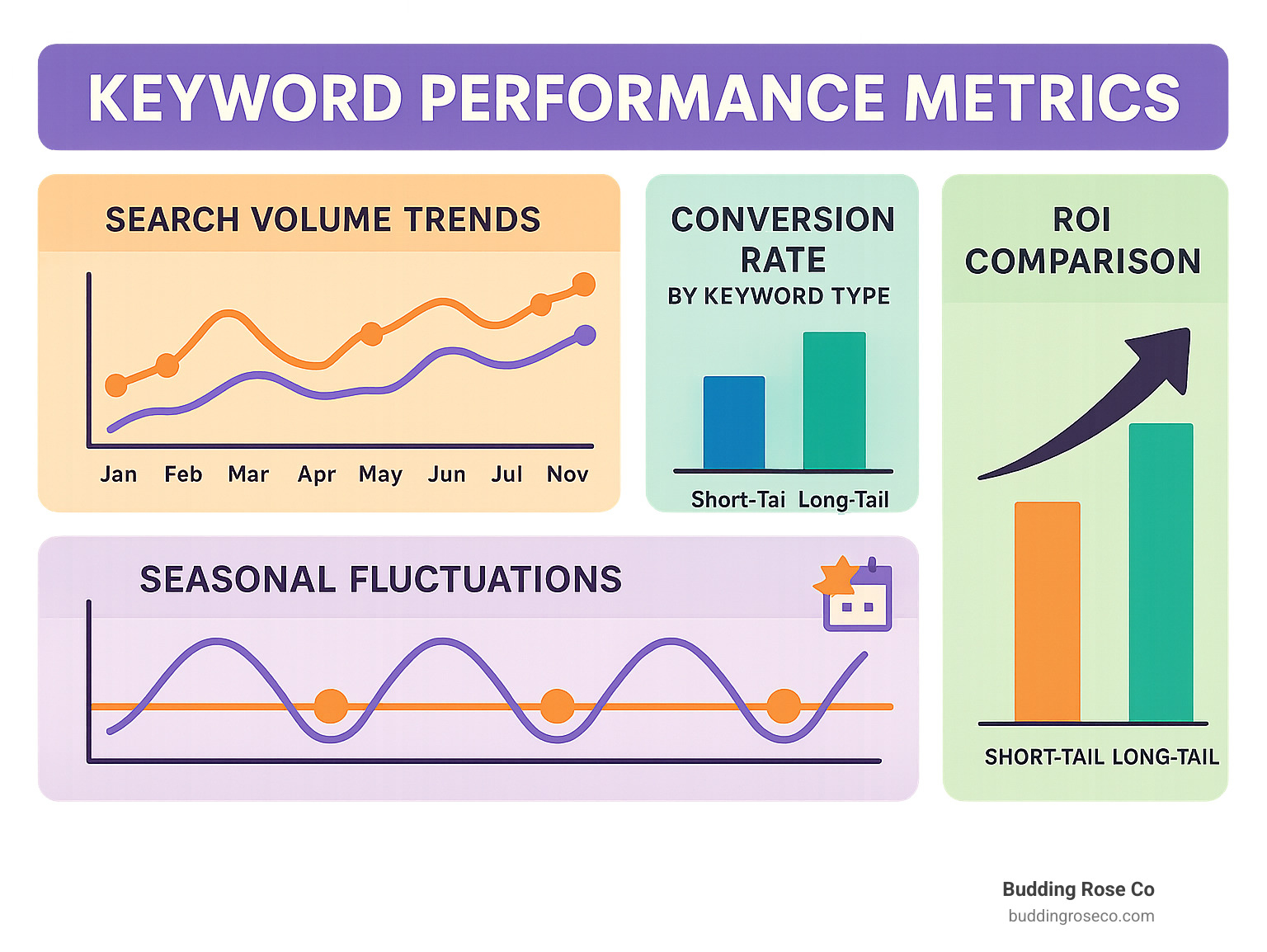
Keyword Know-How – Finding the Right Words for Your Content
Why Keywords Are the Foundation of Your Content Success
A keyword is a word or phrase that people type into search engines when looking for information, products, or services – and understanding how to use them effectively can transform your content's visibility and reach. If you’d like a quick primer on the concept, the Wikipedia article on keywords offers a concise overview.
Quick Answer: What You Need to Know About Keywords - Definition: Words/phrases people search for online - Purpose: Connect your content with your target audience - Types: Short-tail (1–2 words) vs long-tail (3+ words) - Impact: Long-tail keywords convert 70–80% vs short-tail's 15–20% - Tools: Google Keyword Planner, WordStream, Keyword Tool (free options available)
Think of keywords as the bridge between what people are searching for and the content you create. When someone searches for "vibrant summer dresses" or "unique occasion wear," they're using keywords to find exactly what they need.
The challenge? Most content creators guess at what their audience wants instead of researching what they actually search for. This leads to beautiful content that nobody finds.
The opportunity? When you master keyword research, you can create content that naturally attracts your ideal customers. You'll know exactly what questions they're asking and what problems they need solved.

What Are Keywords? The Basics
Think of keywords as the secret language your customers use when they're looking for exactly what you offer. They're the bridge between someone's need and your solution.
When a customer searches for "bright summer dresses for outdoor weddings," they're telling you exactly what they want, when they need it, and how they plan to use it.
Keywords work in two main ways:
Search Engine Optimization (SEO) helps your content show up naturally when people search. Pay-Per-Click (PPC) advertising lets you bid on specific terms to show paid ads.
Here's what makes this powerful: keywords reveal what people actually want, not what we think they want. Instead of guessing, you can create content that speaks directly to their needs using their exact language.
Primary Keyword vs Long-Tail Keyword
Primary keywords are short - usually one or two words like "dresses." They get tons of searches but face fierce competition.
Long-tail keywords are longer phrases that tell a complete story. "Vibrant floral dresses for summer garden parties" is much more specific than just "dresses." These longer phrases get fewer searches, but the people using them know exactly what they want.
Here's the surprising part: long-tail keywords convert at 70-80% while primary keywords only convert at 15-20%. Someone searching for "unique colorful midi dresses under $150" probably has their credit card ready.
The search volume might be lower for long-tail terms, but the competition is much friendlier too. This is why smart content creators focus heavily on long-tail keywords - they bring in customers who are ready to buy, not just browse.
Keyword Types and Match Types
Keywords come in different types, each serving a different purpose in your marketing strategy.
Short-tail keywords are 1-2 word terms with massive search volume but fierce competition. Long-tail keywords are 3+ word phrases with lower search volume but much higher conversion rates.
Branded keywords include your company name. Non-branded keywords are generic terms that help new customers find you.
The intent behind searches matters too. Informational keywords capture people researching. Commercial keywords show buying intent. Transactional keywords indicate someone ready to purchase.
Negative keywords are terms you specifically don't want to show up for, preventing your ads from showing to the wrong audience.
| Match Type | Syntax | Control Level | Reach | Best For |
|---|---|---|---|---|
| Broad Match | keyword | Low | Widest | Findy & volume |
| Phrase Match | "keyword" | Medium | Moderate | Relevant variations |
| Exact Match | [keyword] | High | Narrowest | Precise targeting |
Keyword Match Types Explained
Match types control how closely someone's search needs to match your chosen keyword before your ad appears.
Broad match casts the widest net. When you use broad match for "colorful dresses," your ad might show for "vibrant gowns" or "bright clothing."
Phrase match requires your phrase or close variations. "Colorful dresses" would trigger for "buy colorful dresses online" but not "dresses in bright colors."
Exact match only shows your ad for your exact keyword or extremely close variants. This gives maximum control but minimum reach.
Using Negative Keywords to Refine Traffic
Negative keywords filter out irrelevant traffic. For a dress retailer, negative keywords might include "alterations," "rental," or "costume jewelry."
The beauty of negative keywords lies in improving your ad relevance. When your ads only show to genuinely interested people, your click-through rates improve and costs decrease.
Keyword Research: Tools, Methods, and Metrics
Finding the right keywords isn't about guessing - it's about finding what people actually search for.
Google Keyword Planner remains the gold standard, pulling data directly from Google's search engine. You'll get search volume estimates, competition levels, and bid suggestions.
WordStream's Free Keyword Tool generates hundreds of relevant suggestions with industry-specific filtering. Keyword Tool uses Google's autocomplete feature to uncover up to 750+ long-tail suggestions per search.
But tools are only part of the story. The most revealing research often happens when you talk to actual customers. What words do they use when describing products they love?
Data-Driven Metrics that Matter
Search volume tells you monthly search frequency, but don't get too excited by big numbers. A keyword with 100,000 monthly searches might be impossible to rank for.
Keyword Difficulty (KD) measures ranking difficulty. "Dresses" might have 100% difficulty, while "star-print midi dresses" might score 25%.
Cost Per Click (CPC) reveals commercial value. When advertisers pay $3 per click for "buy summer dresses online" but $0.50 for "dress history," it shows which attracts buyers versus browsers.
Competitive Density measures paid search competition on a 0-1 scale.
Choosing the Best Keyword Research Tool
If you're starting out, Google Keyword Planner and WordStream's free tool provide everything you need. For content creators wanting unique angles, Keyword Tool's autocomplete approach excels at finding long-tail questions.
Free tools offer substantial value when you're learning. Premium tools add convenience but many successful businesses start with free options.

Keyword Strategy: Mapping, Content Optimization, and PPC
Once you've done research, turn those keywords into a strategic roadmap for your content and advertising.
Keyword mapping matches each target keyword to a specific page on your site, preventing multiple pages from fighting for the same search term.
Topic clustering groups related terms around central themes. For vibrant dresses, you might build a cluster around "summer styling" including "how to style colorful summer dresses" supported by "summer dress accessories" and "bright casual outfits."
Keyword Placement for On-Page SEO
Your title tag is prime real estate. Include your main keyword near the beginning, keeping it under 60 characters. Your H1 tag should echo this focus.
Meta descriptions deserve special attention - write them like mini-advertisements around 105 characters that include your primary keyword.
Your URL structure should be clean and descriptive. Use "vibrant-summer-dresses" instead of "product-12345."
Weave keywords into H2 and H3 subheadings naturally. Include your main keyword in the first paragraph and sprinkle related terms throughout.
Don't forget image alt text - describe images accurately while including relevant keywords when appropriate.
Building PPC Ad Groups Around Keyword Clusters
Organize keywords into focused ad groups that tell one clear story. Create an ad group like "Vibrant Summer Dresses" including "colorful summer dresses," "bright floral dresses," and "vibrant casual wear."
Use exact match for proven winners, phrase match for broader reach with control, and broad match with Smart Bidding for new opportunities.
Ensure your landing pages contain the keywords you're bidding on for better Quality Scores and visitor satisfaction.
For deeper insights into styling strategies that inform keyword targeting, check out more info about vibrant dresses.
Keyword Cannibalization: How to Prevent It
Keyword cannibalization happens when multiple pages compete for the same search term. Give each page its own unique primary keyword.
Regular content audits help spot problems. When you find competing pages, consolidate thin content, redirect duplicates, or refocus pages on different keywords.
Tracking Performance, Trends, and Avoiding Mistakes
Keyword performance tracking transforms guesswork into data-driven decisions. Think of tracking as your content's health checkup.
Rank tracking shows where your pages appear in search results over time. Analytics reveal which keywords drive sales, not just traffic.
Google Search Console shows exactly which queries bring people to your site, click-through rates, and rankings. For paid campaigns, Google Ads reports reveal which keywords convert browsers into buyers.
Connect tracking to business outcomes. You might find people searching for "unique colorful dresses" stay longer and buy more than those using generic terms.
Seasonality plays a huge role in fashion. Google Trends reveals patterns - "holiday party dresses" surge in November, while "summer wedding guest dresses" peak in April and May.
Avoid common pitfalls: Keyword stuffing makes content sound robotic. Over-competition means targeting only popular terms while ignoring easier wins. The biggest mistake? Ignoring search intent - match content to what searchers actually want.

Monitoring Keyword ROI Over Time
Conversion rate tells the real story. A keyword bringing 1,000 visitors but zero sales isn't helping your business.
Click-through rate (CTR) reveals how compelling your search listings appear. For paid campaigns, cost per acquisition (CPA) shows exactly what each customer costs.
Track lifetime value of customers from different keywords. People finding you through "unique handmade dresses" might become loyal repeat customers.
Set up monthly reviews to spot trends early. Quick adjustments keep you ahead of the curve.
Adapting to Seasonality and Emerging Trends
Smart keyword planning anticipates seasonal cycles. Start optimizing for "New Year's Eve dresses" in October, not December.
Long-term growth comes from balancing seasonal terms with evergreen content. While "summer sundresses" peaks for months, "how to style colorful dresses" attracts searches year-round.
Watch for emerging fashion trends in social media. Being first to optimize for trending terms gives you huge advantages.

Frequently Asked Questions about Keyword Research
What is search intent and why does it affect keyword choice?
Search intent is what someone really wants when they search. Understanding this can make or break your content strategy.
The four main types:
Informational intent - people want to learn something ("how to style a midi dress") Navigational intent - finding a specific website ("Budding Rose Co website") Commercial intent - researching before buying ("best summer dresses 2024") Transactional intent - ready to buy ("buy colorful dresses online")
Google matches results to what people actually want. If someone searches for dress care tips, Google shows helpful articles, not shopping pages. Fighting against search intent is ineffective.
How often should I update my keyword list?
Quarterly reviews work best, with monthly check-ins during busy periods. Fashion retail experiences dramatic seasonal shifts.
Consumer language evolves constantly. Seasonal patterns hit fashion keywords hard - "summer wedding guest dresses" peaks in spring, while "holiday party outfits" surge in November.
The competitive landscape never stays still. Regular reviews help you double down on what works and abandon what doesn't.
What's the best way to measure keyword performance?
Look beyond surface metrics to understand real business impact. Rankings feel good, but they don't pay bills.
Start with traffic metrics - organic traffic shows SEO success, paid clicks reveal advertising value.
Engagement metrics reveal quality - high bounce rates suggest wrong audience targeting.
Conversion metrics show real value - track which keywords lead to sales or signups.
Business metrics complete the picture - calculate revenue per keyword and customer lifetime value.
Connect everything to actual business outcomes. Give keyword strategies at least a few months to generate meaningful data.
Conclusion
Mastering keyword research transforms your content from guesswork into strategic communication with your ideal customers. At Budding Rose Co., we've learned that finding the right words connects with people who love vibrant, unique fashion.
Think of keywords as the secret language between you and your customers. When someone searches for "colorful party dresses" at 2 AM for a last-minute event, they're speaking your language.
Start with customer language - authentic words people use when excited about finding the perfect dress. Listen to sales conversations, read reviews, and pay attention to social media comments.
Use free tools like Google Keyword Planner and WordStream's free tool to build your initial list. The best tool is one you'll actually use consistently.
Focus on intent rather than just search volume. A hundred people searching for exactly what you offer beats a thousand looking for something different.
Track and adjust based on real performance data. Your keyword strategy should evolve as you learn what resonates with your audience.
Think long-term by building topic clusters around your expertise. Create comprehensive content that establishes authority in vibrant fashion and unique styling.
The fashion industry moves fast, and your keyword strategy should keep pace. Stay curious about how customers search, remain flexible, and always prioritize providing genuine value.
Successful keyword research isn't about perfection from day one - it's about continuous optimization and genuine connection with your audience.
For more insights on creating content that resonates with fashion-forward customers, explore our guide on dress versatility and styling strategies, which demonstrates how understanding customer needs drives both keyword strategy and product development.
Your content success starts with understanding the words your customers use when dreaming about their next favorite dress. Master those words, and you'll master being found by people who need what you offer most.
